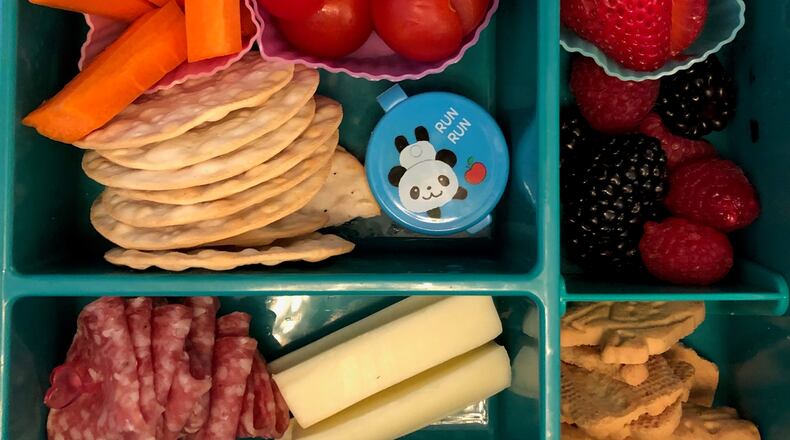The pandemic has disrupted our typical weekdays. For children who are beginning the school year in remote learning environments, it means the loss of school lunchtime. Some depend on school for their meals, and the social and psychological benefits of the lunchroom are immeasurable for all children.
However, there are ways for parents to create some normalcy for their children, even when heading to the school cafeteria isn’t part of the daily lunch drill.
“All kids thrive on routine and structure,” said Laurie Bradley, a marriage and family therapist. “At school, lunch is a break from learning, where they have social interaction, get some fuel in, and then burn that energy off.”
She said parents can use mealtimes to fill that void at home.
“Building that structure at home is important, for them to know what that routine looks like again,” Marietta City Schools Nutrition Director Cindy Kanarek Culver said, “especially for a new kindergartner who hasn’t had that type of structure.”
Bradley suggested getting kids involved in the meal planning, such as deciding which day is pizza day.
Credit: Jennifer Zyman
Credit: Jennifer Zyman
The aspect of school lunch that is lost, and is more difficult to make up for, is social interaction.
“Eating is a very social event, and you learn a lot about manners and time management, because it takes a long time to sit and eat,” Culver said.
Bradley said parents should let their children Zoom or Facetime with other students who are learning virtually during lunchtime, so the kids can socialize and experience “free” time with their peers outside of scheduled classes.
Both experts also recommended adding a physical component for kids, to burn off their extra energy, so recess is a must, even if it is just walking the dog.
“If eating at mealtime has become difficult,” Bradley said, “mixing it up can be fun, and a way to distract from just eating. One idea she offered: “Building a pillow fort and eating lunch under it on a rainy or hot day.”
And, perhaps a carton of chocolate milk or a favorite dessert is a little splurge that will make school at home feel special.
If planning lunches becomes too time-consuming or expensive, Culver said, parents of public school students should take a cue from their school district’s lunch program. “The beauty of the federal school breakfast and lunch program is that it hits everything that you’re after. It’s nutritionally balanced, with fruits, vegetables, whole grains, and everything a child needs for proper growth and development.”
Culver said lunches at school usually cost around $2.40, and you can find out what your district offers by calling.
Credit: Jennifer Zyman
Credit: Jennifer Zyman
Another point is that parents should build in some kindness for themselves.
“Parents are putting a lot of pressure on themselves to be all things to their kids right now, because we’re not in school,” Bradley said. ”It’s OK when things don’t go as planned. If we can remind ourselves that we’ve got these little people watching us, I think it can help us realize that that’s an important skill to learn as an adult. To be, like, let’s pivot, let’s adapt.”
Remote learning doesn’t have to be precisely like school, and it is fine if lunch one day is a microwaved burrito. The real upside for all of these kids will be more time spent with their caregiver, and that’s something even the best schools cannot provide.
Credit: Jennifer Zyman
Credit: Jennifer Zyman
A WEEK OF LUNCH IDEAS
Monday: Pack a lunch the night before in a bento box, or in their favorite lunchbox. Make one for yourself, and enjoy a picnic in your yard.
Tuesday: Serve frozen or takeout pizza, with a salad mix and ranch dressing.
Wednesday: Try minestrone, with whole-wheat pasta, seasonal vegetables, hot garlic bread or Texas toast from the freezer, and fresh fruit. Make a big pot of vegetable soup the night before; cook the pasta separately, so it doesn’t become waterlogged.
Thursday: For taco day, cook the taco meat of your choice (ground turkey, beef or tofu). Chop your family’s favorite toppings, and arrange them on a platter. All you have to do is reheat the meat, warm the tortillas, and set out the toppings.
Friday: Serve tomato sandwiches on your child’s favorite bread, with mayonnaise and salt. For a side, add something crunchy, such as veggie chips or small sweet peppers, plus a dip.
A WEEK OF SNACK IDEAS
Afternoon tea (iced in the summer), with caffeine for you and caffeine-free for the kids. Pair with cookies, or serve with savory sandwiches, like cucumber and cream cheese, or ham and good butter on fluffy white sandwich bread.
Vegetable sticks, with fresh lime juice and chili powder. Cut up cucumbers, carrots, green apples and jicama, squirt with halves of fresh lime, and sprinkle with salt and ground chili powder, like Tajín.
Kid-friendly meat and cheese platter. Use your child’s favorite deli meats. Round out the board with cubed cheese, crackers, raw vegetables, fresh fruit (like apples and grapes), and nuts (assuming allergies aren’t a consideration).
Chicken wings/chilled fried chicken bites from the grocery store, with celery, carrots and ranch dressing. A few chilled, store-bought wings can be the centerpiece of protein-heavy snacks, to get your at-home learners through homework, while also fitting another serving of vegetables into their diet.
Air-popped popcorn. Toss with flavored salt and melted butter.
Read more stories like this by liking Atlanta Restaurant Scene on Facebook, following @ATLDiningNews on Twitter and @ajcdining on Instagram.
About the Author
The Latest
Featured




